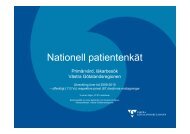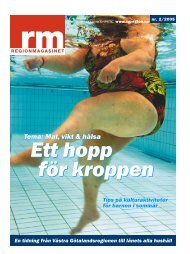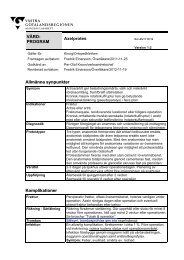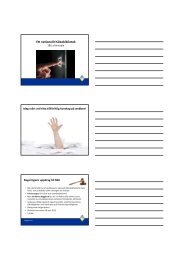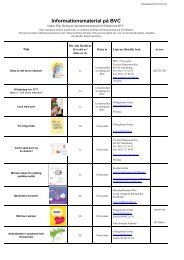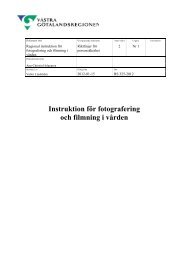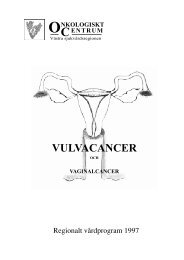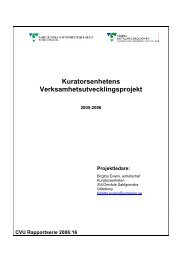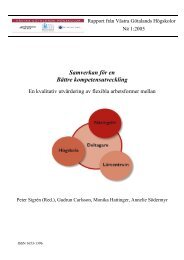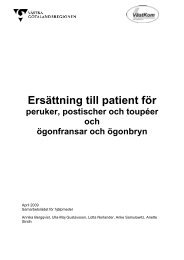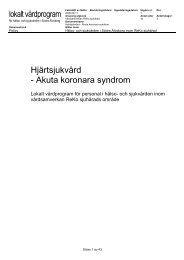FOURTEENTH ANNUAL EUROPEAN PRESSURE ULCER ...
FOURTEENTH ANNUAL EUROPEAN PRESSURE ULCER ...
FOURTEENTH ANNUAL EUROPEAN PRESSURE ULCER ...
You also want an ePaper? Increase the reach of your titles
YUMPU automatically turns print PDFs into web optimized ePapers that Google loves.
Thursday September 1st<br />
Proceedings of the 14th Annual European Pressure Ulcer Meeting<br />
Oporto, Portugal<br />
Pressure ulcers prevalence in critically ill patients: Nursing care, Hospital facilities, and the<br />
prevalence of pressure ulcers in Jordanian Intensive Care Units.<br />
Introduction<br />
Rana Al-Awamleh 1* , Sanaa Al-Awamleh 2 , Marwan Al-Abadi 3<br />
1* University of Sheffield, School of Nursing and Midwifery, United Kingdom,<br />
corresponding author. E-mail address: nrp07ra@sheffield.ac.uk<br />
2 Jordanian Royal Medical Services, Jordan, 3 Jordanian Royal Medical Services, Jordan<br />
Pressure ulcers remain a serious problem in intensive<br />
care units in Jordan. There is very limited literature<br />
about this topic and the relationship between pressure<br />
ulcer development, the quality of care and the<br />
availability of hospital facilities.Therefore, this study<br />
aimed to investigate the pressure ulcers prevalence in<br />
government and private Jordanian hospitals, assess<br />
the nurses’ knowledge regarding pressure ulcers<br />
prevention measures, and evaluate the availability of<br />
the hospitals facilities and polices towards PUs care.<br />
Methods<br />
A descriptive cross-sectional comparison design and a<br />
prospective cross-sectional comparison design were<br />
used. First, an assessment of pressure ulcer<br />
prevalence through (EPUAP) prevalence survey was<br />
carried out. A total of 80 critically ill patients with<br />
pressure ulcers were included. PU prevalence data<br />
was analyzed by frequency distribution to determine<br />
the PU prevalence, and then the inferential statistics<br />
were used: Mann-Whitney U test, independent group ttest,<br />
and Chi-Square test. Second the nurses’<br />
knowledge, interventions, and the availability of the<br />
hospitals facilities were assessed by using two survey<br />
questionnaires; the knowledge survey questionnaire,<br />
and interventions and hospital facilities questionnaire.<br />
A total of 115 registered nurses in the ICU in the six<br />
hospitals took part in the survey. Data analysis was<br />
carried out through different tests; knowledge<br />
questionnaire by descriptive statistics and Chi-Square<br />
test to compare the nurses’ knowledge perception<br />
between the two sectors. While, nursing interventions<br />
and hospital facilities survey through frequency<br />
distribution, Mann-Whitney U test, and Chi-Square<br />
test.<br />
Results<br />
Overall PU prevalence was 13%.<br />
Table 1: PU prevalence in both government and private<br />
hospitals.<br />
Institution PU Prevalence<br />
Government 14%<br />
Private 11%<br />
There is a lack in the knowledge dissemination<br />
particularly about non-useful measures, while useful<br />
preventive measures are more familiar among nurses.<br />
81<br />
Private hospitals were better than government<br />
hospitals in the availability and applicability of the most<br />
PUs prevention measures, PUs care policies, and staff<br />
education.<br />
Discussion<br />
PUs prevalence in Jordan was low comparing with<br />
many European counties for example; Germany<br />
(21.1%) [1], Australia (28.2%) [2], Italy (27%) [3], these<br />
results may be due to the differences in the<br />
demographic data and health care systems between<br />
Jordan and European countries. The prevalence in this<br />
study is close to the results were found previously in<br />
Jordan (12%) [4]. the nurses’ knowledge in Jordanian<br />
hospitals regarding the usefulness of pressure ulcers<br />
preventive measures are not up-to-date, which was<br />
similar to the nurses’ knowledge in Dutch hospitals [5].<br />
Clinical relevance<br />
This study considered as an original study because<br />
only one published work was found about this topic in<br />
Jordan, It is difficult to generalise western studies and<br />
apply their results in attempt to solve this problem in<br />
Jordan. The findings will guide policy makers,<br />
employers, nurses into promoting and enhancing the<br />
pressure ulcer care.<br />
Acknowledgements<br />
We appreciate the help of everyone who facilitate the<br />
process of this research, especially Prof Roger<br />
Watson, Dr Mark Limb, and Prof Ruud Halfens.<br />
Conflict of Interest<br />
There are no conflicts of interest<br />
References<br />
[1] Lahmann N. et al., J. Ostomy/Wound<br />
Management.52: 20-33, 2006.<br />
[2] Gardner A. et al., J. Wound Practice and Research.<br />
17:134-145, 2009.<br />
[3] Capon A. et al., J. Advanced Nursing. 58: 263-272,<br />
2007.<br />
[4] Tubaishat A. et al., J. Tissue Viability. 20: 14-19,<br />
2011.<br />
[5] Halfens R. et al., J. International Journal of Nursing<br />
Studies. 32: 16-26, 1995.<br />
Copyright © 2011 by EPUAP



